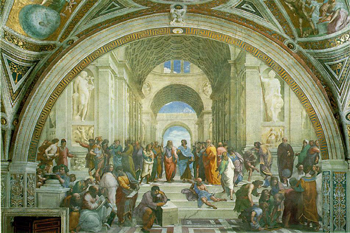
School of Athens

|
While his rival Michelangelo was painting the ceiling of the Sistine Chapel, Raphael was working on another commission for Pope Julius II. Though not attaining nearly the same notoriety as Michelangelo's masterpiece, Raphael's School of Athens nevertheless stands as a key monument in Western painting, and one of the most important works of the Renaissance.
Raphael began painting School in 1509, and it is generally believed that he completed it in 1511. It is also generally accepted that he employed the help of an adviser in planning the work, although this is a debated topic.
Regardless of the nature of its authorship, School of Athens is indeed not only a great achievement of European art, but also a synthesis of all that was Classicist about the Renaissance. Raphael masterfully blended gods and mortals, and men of different eras of history, into a single, mythic space. The painting is populated by the likes of Alcibiades, Socrates, Ptolemy, Averhöes, Epicurus, Euclid, Minerva, Apollo, Plato, Aristotle, Sodoma, and others. He has assembled into one setting the men who formed the Classical foundation of Western thought.
In terms of composition, School of Athens conforms to a truly traditional style. The poses of the present personages, as required by the Alberti's aesthetics, conform to what is known of their character; therefore, their visual representation is expressive of their personalities. The center of the frame consists of Aristotle and Plato, their position outlined by the distant, small arch, a frame within a frame. The arch above, and their intermediate location in the piece, emphasizes the triumph and centrality of their philosophy.
Light, too, is used in a traditional manner. It unifies the painting, as it enters consistently from the right, casting a warm, radiant glow over the entire work.












